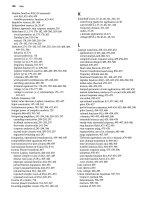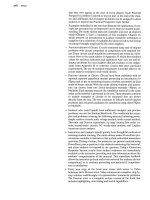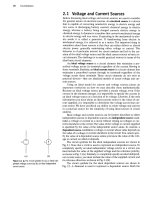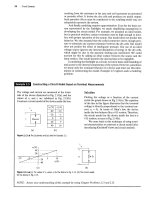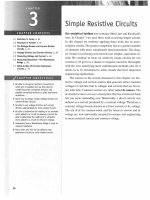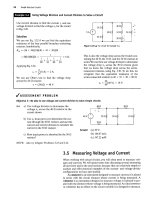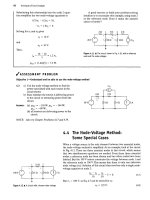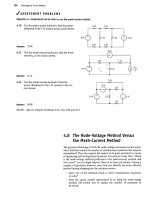Nilsson riedel electric circuits 9th solutions
Bạn đang xem bản rút gọn của tài liệu. Xem và tải ngay bản đầy đủ của tài liệu tại đây (5.35 MB, 936 trang )
INSTRUCTOR'S SOLUTION MANUAL
www.elsolucionario.net
LIBROS UNIVERISTARIOS
Y SOLUCIONARIOS DE
MUCHOS DE ESTOS LIBROS
LOS SOLUCIONARIOS
CONTIENEN TODOS LOS
EJERCICIOS DEL LIBRO
RESUELTOS Y EXPLICADOS
DE FORMA CLARA
VISITANOS PARA
DESARGALOS GRATIS.
www.elsolucionario.net
Circuit Variables
1
Assessment Problems
AP 1.1 Use a product of ratios to convert two-thirds the speed of light from meters
per second to miles per second:
2 3 × 108 m 100 cm
1 in
1 ft
1 mile
124,274.24 miles
·
·
·
·
=
3
1s
1m
2.54 cm 12 in 5280 feet
1s
Now set up a proportion to determine how long it takes this signal to travel
1100 miles:
124,274.24 miles
1100 miles
=
1s
xs
Therefore,
x=
1100
= 0.00885 = 8.85 × 10−3 s = 8.85 ms
124,274.24
AP 1.2 To solve this problem we use a product of ratios to change units from
dollars/year to dollars/millisecond. We begin by expressing $10 billion in
scientific notation:
$100 billion = $100 × 109
Now we determine the number of milliseconds in one year, again using a
product of ratios:
1 year
1 day
1 hour 1 min
1 sec
1 year
·
·
·
·
=
365.25 days 24 hours 60 mins 60 secs 1000 ms 31.5576 × 109 ms
Now we can convert from dollars/year to dollars/millisecond, again with a
product of ratios:
$100 × 109
1 year
100
·
=
= $3.17/ms
9
1 year
31.5576 × 10 ms
31.5576
© 2010 Pearson Education, Inc., Upper Saddle River, NJ. All rights reserved. This publication is protected by Copyright and written permission should be
obtained from the publisher prior to any prohibited reproduction, storage in a retrieval
1–1 system, or transmission in any form or by any means, electronic,
mechanical, photocopying, recording, or likewise. For information regarding permission(s), write to: Rights and Permissions Department,
Pearson Education, Inc., Upper Saddle River, NJ 07458.
www.elsolucionario.net
1–2
CHAPTER 1. Circuit Variables
AP 1.3 Remember from Eq. (1.2), current is the time rate of change of charge, or
i = dq
In this problem, we are given the current and asked to find the total
dt
charge. To do this, we must integrate Eq. (1.2) to find an expression for
charge in terms of current:
t
q(t) =
0
i(x) dx
We are given the expression for current, i, which can be substituted into the
above expression. To find the total charge, we let t → ∞ in the integral. Thus
we have
∞
qtotal =
=
0
20e−5000x dx =
20 −5000x ∞
20
e
=
(e−∞ − e0)
−5000
−5000
0
20
20
(0 − 1) =
= 0.004 C = 4000 µC
−5000
5000
AP 1.4 Recall from Eq. (1.2) that current is the time rate of change of charge, or
i = dq
. In this problem we are given an expression for the charge, and asked to
dt
find the maximum current. First we will find an expression for the current
using Eq. (1.2):
i=
=
dq
d 1
t
1
=
−
+
e−αt
2
2
dt
dt α
α α
d 1
d t −αt
d 1 −αt
−
e
−
e
2
dt α
dt α
dt α2
1 −αt
t
1
e
− α e−αt − −α 2 e−αt
α
α
α
= 0−
= −
1
1 −αt
+t+
e
α
α
= te−αt
Now that we have an expression for the current, we can find the maximum
value of the current by setting the first derivative of the current to zero and
solving for t:
di
d
= (te−αt) = e−αt + t(−α)eαt = (1 − αt)e−αt = 0
dt
dt
Since e−αt never equals 0 for a finite value of t, the expression equals 0 only
when (1 − αt) = 0. Thus, t = 1/α will cause the current to be maximum. For
this value of t, the current is
i=
1 −α/α
1
e
= e−1
α
α
© 2010 Pearson Education, Inc., Upper Saddle River, NJ. All rights reserved. This publication is protected by Copyright and written permission should be
obtained from the publisher prior to any prohibited reproduction, storage in a retrieval system, or transmission in any form or by any means, electronic,
mechanical, photocopying, recording, or likewise. For information regarding permission(s), write to: Rights and Permissions Department,
Pearson Education, Inc., Upper Saddle River, NJ 07458.
www.elsolucionario.net
Problems
1–3
Remember in the problem statement, α = 0.03679. Using this value for α,
i=
1
e−1 ∼
= 10 A
0.03679
AP 1.5 Start by drawing a picture of the circuit described in the problem statement:
Also sketch the four figures from Fig. 1.6:
[a] Now we have to match the voltage and current shown in the first figure
with the polarities shown in Fig. 1.6. Remember that 4A of current
entering Terminal 2 is the same as 4A of current leaving Terminal 1. We
get
(a) v = −20 V,
(c) v = 20 V,
i = −4 A; (b) v = −20 V,
i = −4 A;
(d) v = 20 V,
i = 4A
i = 4A
[b] Using the reference system in Fig. 1.6(a) and the passive sign convention,
p = vi = (−20)(−4) = 80 W. Since the power is greater than 0, the box is
absorbing power.
[c] From the calculation in part (b), the box is absorbing 80 W.
AP 1.6 [a] Applying the passive sign convention to the power equation using the
voltage and current polarities shown in Fig. 1.5, p = vi. To find the time
at which the power is maximum, find the first derivative of the power
with respect to time, set the resulting expression equal to zero, and solve
for time:
p = (80,000te−500t)(15te−500t) = 120 × 104 t2 e−1000t
dp
= 240 × 104 te−1000t − 120 × 107 t2e−1000t = 0
dt
© 2010 Pearson Education, Inc., Upper Saddle River, NJ. All rights reserved. This publication is protected by Copyright and written permission should be
obtained from the publisher prior to any prohibited reproduction, storage in a retrieval system, or transmission in any form or by any means, electronic,
mechanical, photocopying, recording, or likewise. For information regarding permission(s), write to: Rights and Permissions Department,
Pearson Education, Inc., Upper Saddle River, NJ 07458.
www.elsolucionario.net
1–4
CHAPTER 1. Circuit Variables
Therefore,
240 × 104 − 120 × 107 t = 0
Solving,
t=
240 × 104
= 2 × 10−3 = 2 ms
120 × 107
[b] The maximum power occurs at 2 ms, so find the value of the power at 2
ms:
p(0.002) = 120 × 104 (0.002)2 e−2 = 649.6 mW
[c] From Eq. (1.3), we know that power is the time rate of change of energy,
or p = dw/dt. If we know the power, we can find the energy by
integrating Eq. (1.3). To find the total energy, the upper limit of the
integral is infinity:
∞
wtotal =
0
120 × 104 x2e−1000x dx
120 × 104 −1000x
=
e
[(−1000)2 x2 − 2(−1000)x + 2)
(−1000)3
=0−
∞
0
120 × 104 0
e (0 − 0 + 2) = 2.4 mJ
(−1000)3
AP 1.7 At the Oregon end of the line the current is leaving the upper terminal, and
thus entering the lower terminal where the polarity marking of the voltage is
negative. Thus, using the passive sign convention, p = −vi. Substituting the
values of voltage and current given in the figure,
p = −(800 × 103 )(1.8 × 103 ) = −1440 × 106 = −1440 MW
Thus, because the power associated with the Oregon end of the line is
negative, power is being generated at the Oregon end of the line and
transmitted by the line to be delivered to the California end of the line.
© 2010 Pearson Education, Inc., Upper Saddle River, NJ. All rights reserved. This publication is protected by Copyright and written permission should be
obtained from the publisher prior to any prohibited reproduction, storage in a retrieval system, or transmission in any form or by any means, electronic,
mechanical, photocopying, recording, or likewise. For information regarding permission(s), write to: Rights and Permissions Department,
Pearson Education, Inc., Upper Saddle River, NJ 07458.
www.elsolucionario.net
Problems
1–5
Chapter Problems
P 1.1
[a] We can set up a ratio to determine how long it takes the bamboo to grow
10 µm First, recall that 1 mm = 103 µm. Let’s also express the rate of
growth of bamboo using the units mm/s instead of mm/day. Use a
product of ratios to perform this conversion:
250 mm
1 day
1 hour 1 min
250
10
·
·
·
=
=
mm/s
1 day 24 hours 60 min 60 sec
(24)(60)(60)
3456
Use a ratio to determine the time it takes for the bamboo to grow 10 àm:
10/3456 ì 103 m
10 × 10−6 m
=
1s
xs
[b]
P 1.2
so
x=
10 × 10−6
= 3.456 s
10/3456 × 10−3
1 cell length 3600 s (24)(7) hr
·
·
= 175,000 cell lengths/week
3.456 s
1 hr
1 week
Volume = area × thickness
Convert values to millimeters, noting that 10 m2 = 106 mm2
106 = (10 × 106 )(thickness)
⇒ thickness =
106
= 0.10 mm
10 × 106
P 1.3
(260 × 106 )(540)
= 104.4 gigawatt-hours
109
P 1.4
[a]
20,000 photos
x photos
=
3
(11)(15)(1) mm
1 mm3
x=
[b]
16 × 230 bytes
x bytes
=
(11)(15)(1) mm3
(0.2)3 mm3
x=
P 1.5
(20,000)(1)
= 121 photos
(11)(15)(1)
(16 × 230 )(0.008)
= 832,963 bytes
(11)(15)(1)
(480)(320) pixels 2 bytes 30 frames
·
·
= 9.216 × 106 bytes/sec
1 frame
1 pixel
1 sec
(9.216 × 106 bytes/sec)(x secs) = 32 × 230 bytes
x=
32 × 230
= 3728 sec = 62 min 1 hour of video
9.216 ì 106
â 2010 Pearson Education, Inc., Upper Saddle River, NJ. All rights reserved. This publication is protected by Copyright and written permission should be
obtained from the publisher prior to any prohibited reproduction, storage in a retrieval system, or transmission in any form or by any means, electronic,
mechanical, photocopying, recording, or likewise. For information regarding permission(s), write to: Rights and Permissions Department,
Pearson Education, Inc., Upper Saddle River, NJ 07458.
www.elsolucionario.net
1–6
CHAPTER 1. Circuit Variables
5280 ft 2526 lb 1 kg
·
·
= 20.5 × 106 kg
1 mi 1000 ft 2.2 lb
P 1.6
(4 cond.) · (845 mi) ·
P 1.7
w = qV = (1.6022 × 10−19 )(6) = 9.61 × 10−19 = 0.961 aJ
P 1.8
n=
P 1.9
C/m3 =
35 × 10−6 C/s
= 2.18 × 1014 elec/s
1.6022 × 10−19 C/elec
1.6022 × 10−19 C 1029 electrons
×
= 1.6022 × 1010 C/m3
3
1 electron
1m
Cross-sectional area of wire = (0.4 × 10−2 m)(16 × 10−2 m) = 6.4 × 10−4 m2
C/m = (1.6022 × 1010 C/m3)(6.4 × 10−4 m2 ) = 10.254 × 106 C/m
Therefore, i
C
C
m
= (10.254 × 106 )
× avg vel
sec
m
s
Thus, average velocity =
P 1.10
i
1600
=
= 156.04 àm/s
6
10.254 ì 10
10.254 ì 106
First we use Eq. (1.2) to relate current and charge:
i=
dq
= 20 cos 5000t
dt
Therefore, dq = 20 cos 5000t dt
To find the charge, we can integrate both sides of the last equation. Note that
we substitute x for q on the left side of the integral, and y for t on the right
side of the integral:
q(t)
q(0)
dx = 20
t
0
cos 5000y dy
We solve the integral and make the substitutions for the limits of the integral,
remembering that sin 0 = 0:
q(t) − q(0) = 20
sin 5000y
5000
t
=
0
20
20
20
sin 5000t −
sin 5000(0) =
sin 5000t
5000
5000
5000
But q(0) = 0 by hypothesis, i.e., the current passes through its maximum
value at t = 0, so q(t) = 4 × 10−3 sin 5000t C = 4 sin 5000t mC
© 2010 Pearson Education, Inc., Upper Saddle River, NJ. All rights reserved. This publication is protected by Copyright and written permission should be
obtained from the publisher prior to any prohibited reproduction, storage in a retrieval system, or transmission in any form or by any means, electronic,
mechanical, photocopying, recording, or likewise. For information regarding permission(s), write to: Rights and Permissions Department,
Pearson Education, Inc., Upper Saddle River, NJ 07458.
www.elsolucionario.net
Problems
P 1.11
1–7
[a] In Car A, the current i is in the direction of the voltage drop across the 12
V battery(the current i flows into the + terminal of the battery of Car
A). Therefore using the passive sign convention,
p = vi = (30)(12) = 360 W.
Since the power is positive, the battery in Car A is absorbing power, so
Car A must have the ”dead” battery.
[b] w(t) =
t
0
p dx;
1 min = 60 s
60
w(60) =
0
360 dx
w = 360(60 − 0) = 360(60) = 21,600 J = 21.6 kJ
P 1.12
p = (12)(100 × 10−3 ) = 1.2 W;
4 hr ·
t
w(t) =
P 1.13
p = vi;
0
3600 s
= 14,400 s
1 hr
14,400
p dt
w=
w(14,400) =
t
0
0
1.2 dt = 1.2(14,400) = 17.28 kJ
p dx
Since the energy is the area under the power vs. time plot, let us plot p vs. t.
Note that in constructing the plot above, we used the fact that 40 hr
= 144,000 s = 144 ks
p(0) = (1.5)(9 × 10−3 ) = 13.5 × 10−3 W
p(144 ks) = (1)(9 × 10−3 ) = 9 × 10−3 W
1
w = (9 × 10−3 )(144 × 103 ) + (13.5 × 10−3 − 9 × 10−3 )(144 × 103 ) = 1620 J
2
P 1.14
Assume we are standing at box A looking toward box B. Then, using the
passive sign convention p = −vi, since the current i is flowing into the −
terminal of the voltage v. Now we just substitute the values for v and i into
the equation for power. Remember that if the power is positive, B is absorbing
power, so the power must be flowing from A to B. If the power is negative, B
is generating power so the power must be flowing from B to A.
© 2010 Pearson Education, Inc., Upper Saddle River, NJ. All rights reserved. This publication is protected by Copyright and written permission should be
obtained from the publisher prior to any prohibited reproduction, storage in a retrieval system, or transmission in any form or by any means, electronic,
mechanical, photocopying, recording, or likewise. For information regarding permission(s), write to: Rights and Permissions Department,
Pearson Education, Inc., Upper Saddle River, NJ 07458.
www.elsolucionario.net
1–8
CHAPTER 1. Circuit Variables
[a] p = −(125)(10) = −1250 W
[b] p = −(−240)(5) = 1200 W
[c] p = −(480)(−12) = 5760 W
1250 W from B to A
1200 W from A to B
5760 W from A to B
[d] p = −(−660)(−25) = −16,500 W
P 1.15
16,500 W from B to A
[a]
p = vi = (40)(−10) = −400 W
Power is being delivered by the box.
[b] Entering
[c] Gaining
P 1.16
[a] p = vi = (−60)(−10) = 600 W, so power is being absorbed by the box.
[b] Entering
[c] Losing
P 1.17
[a] p = vi = (0.05e−1000t )(75 − 75e−1000t) = (3.75e−1000t − 3.75e−2000t) W
dp
= −3750e−1000t + 7500e−2000t = 0
dt
2 = e1000t
so
ln 2 = 1000t
so
thus
2e−2000t = e−1000t
p is maximum at t = 693.15 µs
pmax = p(693.15 µs) = 937.5 mW
∞
[b] w =
=
P 1.18
0
[3.75e−1000t − 3.75e−2000t] dt =
3.75 −1000t
3.75 −2000t ∞
e
−
e
−1000
−2000
0
3.75
3.75
−
= 1.875 mJ
1000 2000
[a] p = vi = 0.25e−3200t − 0.5e−2000t + 0.25e−800t
p(625 µs) = 42.2 mW
[b]
w(t)
=
t
0
(0.25e−3200t − 0.5e−2000t + 0.25e−800t )
= 140.625 − 78.125e−3200t + 250e−2000t − 312.5e−800t µJ
w(625 µs)
= 12.14 µJ
© 2010 Pearson Education, Inc., Upper Saddle River, NJ. All rights reserved. This publication is protected by Copyright and written permission should be
obtained from the publisher prior to any prohibited reproduction, storage in a retrieval system, or transmission in any form or by any means, electronic,
mechanical, photocopying, recording, or likewise. For information regarding permission(s), write to: Rights and Permissions Department,
Pearson Education, Inc., Upper Saddle River, NJ 07458.
www.elsolucionario.net
Problems
1–9
[c] wtotal = 140.625 µJ
P 1.19
[a] 0 s ≤ t < 1 s:
v = 5 V;
i = 20t A;
p = 100t W
i = 20 A;
p=0W
1 s < t ≤ 3 s:
v = 0 V;
3 s ≤ t < 5 s:
v = −5 V; i = 80 − 20t A;
p = 100t − 400 W
5 s < t ≤ 7 s:
v = 5 V;
i = 20t − 120 A; p = 100t − 600 W
t > 7 s:
v = 0 V;
i = 20 A;
p=0W
[b] Calculate the area under the curve from zero up to the desired time:
P 1.20
w(1)
=
1
(1)(100)
2
= 50 J
w(6)
=
1
(1)(100)
2
− 12 (1)(100) + 12 (1)(100) − 12 (1)(100) = 0 J
w(10)
=
w(6) + 21 (1)(100) = 50 J
[a] v(10 ms) = 400e−1 sin 2 = 133.8 V
i(10 ms) = 5e−1 sin 2 = 1.67 A
p(10 ms) = vi = 223.80 W
© 2010 Pearson Education, Inc., Upper Saddle River, NJ. All rights reserved. This publication is protected by Copyright and written permission should be
obtained from the publisher prior to any prohibited reproduction, storage in a retrieval system, or transmission in any form or by any means, electronic,
mechanical, photocopying, recording, or likewise. For information regarding permission(s), write to: Rights and Permissions Department,
Pearson Education, Inc., Upper Saddle River, NJ 07458.
www.elsolucionario.net
1–10
CHAPTER 1. Circuit Variables
[b]
p
= vi = 2000e−200t sin2 200t
1 1
= 2000e−200t
− cos 400t
2 2
= 1000e−200t − 1000e−200t cos 400t
w
=
∞
∞
1000e−200t dt −
0
e−200t
= 1000
−200
0
0
e−200t
−1000
[−200 cos 400t + 400 sin 400t]
(200)2 + (400)2
200
= 5 − 1000
= 5−1
4
4 × 10 + 16 × 104
= 4 J
w
P 1.21
∞
1000e−200t cos 400t dt
∞
0
[a]
p
= vi = [16,000t + 20)e−800t][(128t + 0.16)e−800t ]
= 2048 × 103 t2 e−1600t + 5120te−1600t + 3.2e−1600t
= 3.2e−1600t[640,000t2 + 1600t + 1]
dp
dt
= 3.2{e−1600t[1280 × 103 t + 1600] − 1600e−1600t [640,000t2 + 1600t + 1]}
= −3.2e−1600t[128 × 104 (800t2 + t)] = −409.6 × 104 e−1600tt(800t + 1)
dp
Therefore,
= 0 when t = 0
dt
so pmax occurs at t = 0.
[b] pmax
= 3.2e−0 [0 + 0 + 1]
= 3.2 W
t
[c]
w
w
3.2
=
=
0
0
pdx
t
640,000x2 e−1600x dx +
t
0
1600xe−1600x dx +
t
t
0
e−1600x dx
640,000e−1600x
=
[256 × 104 x2 + 3200x + 2] +
−4096 × 106
0
t
t
1600e−1600x
e−1600x
(−1600x − 1) +
256 × 104
−1600 0
0
When t → ∞ all the upper limits evaluate to zero, hence
w
(640,000)(2)
1600
1
=
+
+
3.2
4096 × 106
256 × 104 1600
w = 10−3 + 2 × 10−3 + 2 × 10−3 = 5 mJ.
© 2010 Pearson Education, Inc., Upper Saddle River, NJ. All rights reserved. This publication is protected by Copyright and written permission should be
obtained from the publisher prior to any prohibited reproduction, storage in a retrieval system, or transmission in any form or by any means, electronic,
mechanical, photocopying, recording, or likewise. For information regarding permission(s), write to: Rights and Permissions Department,
Pearson Education, Inc., Upper Saddle River, NJ 07458.
www.elsolucionario.net
Problems
P 1.22
[a]
p =
dp
dt
1–11
vi
=
400 × 103 t2 e−800t + 700te−800t + 0.25e−800t
=
e−800t[400,000t2 + 700t + 0.25]
=
{e−800t[800 × 103 t + 700] − 800e−800t [400,000t2 + 700t + 0.25]}
=
[−3,200,000t2 + 2400t + 5]100e−800t
dp
Therefore,
= 0 when 3,200,000t2 − 2400t − 5 = 0
dt
so pmax occurs at t = 1.68 ms.
[b] pmax
= [400,000(.00168)2 + 700(.00168) + 0.25]e−800(.00168)
= 666 mW
[c] w
t
=
w
0
=
0
t
pdx
400,000x2 e−800x dx +
t
0
700xe−800x dx +
t
t
0
0.25e−800x dx
400,000e−800x
[64 × 104 x2 + 1600x + 2] +
−512 × 106
0
t
t
700e−800x
e−800x
(−800x − 1) + 0.25
64 × 104
−800 0
0
When t = ∞ all the upper limits evaluate to zero, hence
(400,000)(2)
700
0.25
w=
+
+
= 2.97 mJ.
512 × 106
64 × 104
800
=
P 1.23
[a] p = vi = 2000 cos(800πt) sin(800πt) = 1000 sin(1600πt) W
Therefore, pmax = 1000 W
[b] pmax (extracting) = 1000 W
[c] pavg
2.5×10−3
1
1000 sin(1600πt) dt
2.5 × 10−3 0
2.5×10−3
250
5 − cos 1600πt
4 × 10
=
[1 − cos 4π] = 0
1600π
π
0
=
=
[d]
pavg
=
=
P 1.24
[a] q
=
=
=
15.625×10−3
1
1000 sin(1600πt) dt
15.625 × 10−3 0
15.625×10−3
40
3 − cos 1600πt
64 × 10
= [1 − cos 25π] = 25.46 W
1600π
π
0
area under i vs. t plot
1
(5)(4)
2
+ (10)(4) + 12 (8)(4) + (8)(6) + 12 (3)(6) × 103
[10 + 40 + 16 + 48 + 9]103 = 123,000 C
© 2010 Pearson Education, Inc., Upper Saddle River, NJ. All rights reserved. This publication is protected by Copyright and written permission should be
obtained from the publisher prior to any prohibited reproduction, storage in a retrieval system, or transmission in any form or by any means, electronic,
mechanical, photocopying, recording, or likewise. For information regarding permission(s), write to: Rights and Permissions Department,
Pearson Education, Inc., Upper Saddle River, NJ 07458.
www.elsolucionario.net
1–12
CHAPTER 1. Circuit Variables
[b] w
=
p dt =
vi dt
v = 0.2 × 10−3 t + 9
0 ≤ t ≤ 15 ks
0 ≤ t ≤ 4000s
i = 15 − 1.25 × 10−3 t
= 135 − 8.25 × 10−3 t − 0.25 × 10−6 t2
p
w1
=
4000
0
(135 − 8.25 × 10−3 t − 0.25 × 10−6 t2) dt
= (540 − 66 − 5.3333)103 = 468.667 kJ
4000 ≤ t ≤ 12,000
i
= 12 − 0.5 × 10−3 t
p
= 108 − 2.1 × 10−3 t − 0.1 × 10−6 t2
12,000
w2
=
4000
(108 − 2.1 × 10−3 t − 0.1 × 10−6 t2) dt
= (864 − 134.4 − 55.467)103 = 674.133 kJ
12,000 ≤ t ≤ 15,000
i =
30 − 2 × 10−3 t
p =
270 − 12 × 10−3 t − 0.4 × 10−6 t2
w3
=
wT
P 1.25
15,000
12,000
(270 − 12 × 10−3 t − 0.4 × 10−6 t2) dt
=
(810 − 486 − 219.6)103 = 104.4 kJ
=
w1 + w2 + w3 = 468.667 + 674.133 + 104.4 = 1247.2 kJ
[a] We can find the time at which the power is a maximum by writing an
expression for p(t) = v(t)i(t), taking the first derivative of p(t)
and setting it to zero, then solving for t. The calculations are shown below:
p
p
dp
dt
dp
dt
t1
= 0 t < 0,
p = 0 t > 40 s
= vi = t(1 − 0.025t)(4 − 0.2t) = 4t − 0.3t2 + 0.005t3 W
0 ≤ t ≤ 40 s
= 4 − 0.6t + 0.015t2 = 0.015(t2 − 40t + 266.67)
= 0
when t2 − 40t + 266.67 = 0
= 8.453 s;
t2 = 31.547 s
(using the polynomial solver on your calculator)
p(t1 )
= 4(8.453) − 0.3(8.453)2 + 0.005(8.453)3 = 15.396 W
p(t2 ) = 4(31.547) − 0.3(31.547)2 + 0.005(31.547)3 = −15.396 W
Therefore, maximum power is being delivered at t = 8.453 s.
[b] The maximum power was calculated in part (a) to determine the time at
which the power is maximum: pmax = 15.396 W (delivered)
© 2010 Pearson Education, Inc., Upper Saddle River, NJ. All rights reserved. This publication is protected by Copyright and written permission should be
obtained from the publisher prior to any prohibited reproduction, storage in a retrieval system, or transmission in any form or by any means, electronic,
mechanical, photocopying, recording, or likewise. For information regarding permission(s), write to: Rights and Permissions Department,
Pearson Education, Inc., Upper Saddle River, NJ 07458.
www.elsolucionario.net
Problems
1–13
[c] As we saw in part (a), the other “maximum” power is actually a
minimum, or the maximum negative power. As we calculated in part (a),
maximum power is being extracted at t = 31.547 s.
[d] This maximum extracted power was calculated in part (a) to determine
the time at which power is maximum: pmax = 15.396 W (extracted)
[e] w =
t
0
pdx =
t
0
(4x − 0.3x2 + 0.005x3 )dx = 2t2 − 0.1t3 + 0.00125t4
w(0)
=
0J
w(30)
= 112.5 J
w(10)
=
112.5 J
w(40)
= 0J
w(20) = 200 J
To give you a feel for the quantities of voltage, current, power, and energy
and their relationships among one another, they are plotted below:
© 2010 Pearson Education, Inc., Upper Saddle River, NJ. All rights reserved. This publication is protected by Copyright and written permission should be
obtained from the publisher prior to any prohibited reproduction, storage in a retrieval system, or transmission in any form or by any means, electronic,
mechanical, photocopying, recording, or likewise. For information regarding permission(s), write to: Rights and Permissions Department,
Pearson Education, Inc., Upper Saddle River, NJ 07458.
www.elsolucionario.net
1–14
P 1.26
CHAPTER 1. Circuit Variables
We use the passive sign convention to determine whether the power equation
is p = vi or p = −vi and substitute into the power equation the values for v
and i, as shown below:
pa
=
vaia = (150 × 103 )(0.6 × 10−3 ) = 90 W
pb
=
vbib = (150 × 103 )(−1.4 × 10−3 ) = −210 W
pc
=
−vcic = −(100 × 103 )(−0.8 × 10−3 ) = 80 W
pd
=
vdid = (250 × 103 )(−0.8 × 10−3 ) = −200 W
pe
=
−veie = −(300 × 103 )(−2 × 10−3 ) = 600 W
pf = vf if = (−300 × 103 )(1.2 × 10−3 ) = −360 W
Remember that if the power is positive, the circuit element is absorbing
power, whereas is the power is negative, the circuit element is developing
power. We can add the positive powers together and the negative powers
together — if the power balances, these power sums should be equal:
Pdev = 210 + 200 + 360 = 770 W;
Pabs = 90 + 80 + 600 = 770 W
Thus, the power balances and the total power developed in the circuit is 770
W.
P 1.27
pa
=
−vaia = −(990)(−0.0225) = 22.275 W
pb
=
−vbib = −(600)(−0.03) = 18 W
pc
=
vcic = (300)(0.06) = 18 W
pd
=
vdid = (105)(0.0525) = 5.5125 W
pe
=
−veie = −(−120)(0.03) = 3.6 W
pf
=
vf if = (165)(0.0825) = 13.6125 W
pg
=
−vgig = −(585)(0.0525) = −30.7125 W
ph = vhih = (−585)(0.0825) = −48.2625 W
Therefore,
Pabs = 22.275 + 18 + 18 + 5.5125 + 3.6 + 13.6125 = 81 W
© 2010 Pearson Education, Inc., Upper Saddle River, NJ. All rights reserved. This publication is protected by Copyright and written permission should be
obtained from the publisher prior to any prohibited reproduction, storage in a retrieval system, or transmission in any form or by any means, electronic,
mechanical, photocopying, recording, or likewise. For information regarding permission(s), write to: Rights and Permissions Department,
Pearson Education, Inc., Upper Saddle River, NJ 07458.
www.elsolucionario.net
Problems
1–15
Pdel = 30.7125 + 48.2625 = 78.975 W
Pabs =
Pdel
Thus, the interconnection does not satisfy the power check.
P 1.28
[a] From the diagram and the table we have
pa
=
−vaia = −(46.16)(−6) = −276.96 W
pb
=
vbib = (14.16)(4.72) = 66.8352 W
pc
=
vcic = (−32)(−6.4) = 204.8 W
pd
=
−vdid = −(22)(1.28) = −28.16 W
pe
=
−veie = −(33.6)(1.68) = −56.448 W
pf
=
vf if = (66)(−0.4) = −26.4 W
pg
=
vg ig = (2.56)(1.28) = 3.2768 W
ph
=
−vhih = −(−0.4)(0.4) = 0.16 W
Pdel
= 276.96 + 28.16 + 56.448 + 26.4 = 387.968 W
Pabs
= 66.8352 + 204.8 + 3.2768 + 0.16 = 275.072 W
Therefore,
Pdel =
Pabs and the subordinate engineer is correct.
[b] The difference between the power delivered to the circuit and the power
absorbed by the circuit is
−387.986 + 275.072 = −112.896 W
One-half of this difference is −56.448 W, so it is likely that pe is in error.
Either the voltage or the current probably has the wrong sign. (In
Chapter 2, we will discover that using KCL at the node connecting
components b, c, and e, the current ie should be −1.68 A, not 1.68 A!) If
the sign of pe is changed from negative to positive, we can recalculate the
power delivered and the power absorbed as follows:
Pdel
= 276.96 + 28.16 + 26.4 = 331.52 W
Pabs = 66.8352 + 204.8 + 56.448 + 3.2768 + 0.16 = 331.52 W
Now the power delivered equals the power absorbed and the power
balances for the circuit.
P 1.29
[a] From an examination of reference polarities, elements a, e, f, and h use a
+ sign in the power equation, so would be expected to absorb power.
Elements b, c, d, and g use a − sign in the power equation, so would be
expected to supply power.
© 2010 Pearson Education, Inc., Upper Saddle River, NJ. All rights reserved. This publication is protected by Copyright and written permission should be
obtained from the publisher prior to any prohibited reproduction, storage in a retrieval system, or transmission in any form or by any means, electronic,
mechanical, photocopying, recording, or likewise. For information regarding permission(s), write to: Rights and Permissions Department,
Pearson Education, Inc., Upper Saddle River, NJ 07458.
www.elsolucionario.net
1–16
CHAPTER 1. Circuit Variables
[b]
pa
=
va ia = (5)(2 × 10−3 ) = 10 mW
pb
=
−vbib = −(1)(3 × 10−3 ) = −3 mW
pc
=
−vcic = −(7)(−2 × 10−3 ) = 14 mW
pd
=
−vdid = −(−9)(1 × 10−3 ) = 9 mW
pe
=
ve ie = (−20)(5 × 10−3 ) = −100 mW
pf
=
vf if = (20)(2 × 10−3 ) = 40 mW
pg
=
−vg ig = −(−3)(−2 × 10−3 ) = −6 mW
ph
=
vhih = (−12)(−3 × 10−3 ) = 36 mW
Pabs = 10 + 14 + 9 + 40 + 36 = 109 mW
Pdel = 3 + 100 + 6 = 109 mW
Thus, 109 mW of power is delivered and 109 mW of power is absorbed,
and the power balances.
[c] Looking at the calculated power values, elements a, c, d, f, and h have
positive power, so are absorbing, while elements b, e, and g have negative
power so are supplying. These answers are different from those in part
(a) because the voltages and currents used in the power equation are not
all positive numbers.
P 1.30
pa
=
−vaia = −(1.6)(0.080) = −128 mW
pb
=
−vbib = −(2.6)(0.060) = −156 mW
pc
=
vcic = (−4.2)(−0.050) = 210 mW
pd
=
−vdid = −(1.2)(0.020) = −24 mW
pe
=
veie = (1.8)(0.030) = 54 mW
pf
=
−vf if = −(−1.8)(−0.040) = −72 mW
pg
=
vgig = (−3.6)(−0.030) = 108 mW
ph
=
vhih = (3.2)(−0.020) = −64 mW
pj
=
−vjij = −(−2.4)(0.030) = 72 mW
Pdel = 128 + 156 + 24 + 72 + 64 = 444 mW
Pabs = 210 + 54 + 108 + 72 = 444 mW
Therefore,
Pdel = Pabs = 444 mW
Thus, the interconnection satisfies the power check.
© 2010 Pearson Education, Inc., Upper Saddle River, NJ. All rights reserved. This publication is protected by Copyright and written permission should be
obtained from the publisher prior to any prohibited reproduction, storage in a retrieval system, or transmission in any form or by any means, electronic,
mechanical, photocopying, recording, or likewise. For information regarding permission(s), write to: Rights and Permissions Department,
Pearson Education, Inc., Upper Saddle River, NJ 07458.
www.elsolucionario.net
Problems
P 1.31
pa
=
vaia = (120)(−10) = −1200 W
pb
=
−vbib = −(120)(9) = −1080 W
pc
=
vcic = (10)(10) = 100 W
pd
=
−vdid = −(10)(−1) = 10 W
pe
=
veie = (−10)(−9) = 90 W
pf
=
−vf if = −(−100)(5) = 500 W
pg
=
vgig = (120)(4) = 480 W
ph
=
vhih = (−220)(−5) = 1100 W
1–17
Pdel = 1200 + 1080 = 2280 W
Pabs = 100 + 10 + 90 + 500 + 480 + 1100 = 2280 W
Therefore,
Pdel = Pabs = 2280 W
Thus, the interconnection now satisfies the power check.
P 1.32
[a] The revised circuit model is shown below:
[b] The expression for the total power in this circuit is
va ia − vb ib − vf if + vg ig + vh ih
= (120)(−10) − (120)(10) − (−120)(3) + 120ig + (−240)(−7) = 0
Therefore,
120ig = 1200 + 1200 − 360 − 1680 = 360
so
360
=3A
120
Thus, if the power in the modified circuit is balanced the current in
component g is 3 A.
ig =
© 2010 Pearson Education, Inc., Upper Saddle River, NJ. All rights reserved. This publication is protected by Copyright and written permission should be
obtained from the publisher prior to any prohibited reproduction, storage in a retrieval system, or transmission in any form or by any means, electronic,
mechanical, photocopying, recording, or likewise. For information regarding permission(s), write to: Rights and Permissions Department,
Pearson Education, Inc., Upper Saddle River, NJ 07458.
www.elsolucionario.net
Circuit Elements
2
Assessment
a
Problems
AP 2.1
[a] Note that the current ib is in the same circuit branch as the 8 A current
source; however, ib is defined in the opposite direction of the current
source. Therefore,
ib = −8 A
Next, note that the dependent voltage source and the independent
voltage source are in parallel with the same polarity. Therefore, their
voltages are equal, and
ib
−8
vg =
=
= −2 V
4
4
[b] To find the power associated with the 8 A source, we need to find the
voltage drop across the source, vi . Note that the two independent sources
are in parallel, and that the voltages vg and v1 have the same polarities,
so these voltages are equal:
vi = vg = −2 V
Using the passive sign convention,
ps = (8 A)(vi ) = (8 A)(−2 V) = −16 W
Thus the current source generated 16 W of power.
© 2010 Pearson Education, Inc., Upper Saddle River, NJ. All rights reserved. This publication is protected by Copyright and written permission should be
obtained from the publisher prior to any prohibited reproduction, storage in a retrieval
2–1 system, or transmission in any form or by any means, electronic,
mechanical, photocopying, recording, or likewise. For information regarding permission(s), write to: Rights and Permissions Department,
Pearson Education, Inc., Upper Saddle River, NJ 07458.
www.elsolucionario.net
2–2
CHAPTER 2. Circuit Elements
AP 2.2
[a] Note from the circuit that vx = −25 V. To find α note that the two
current sources are in the same branch of the circuit but their currents
flow in opposite directions. Therefore
αvx = −15 A
Solve the above equation for α and substitute for vx,
α=
−15 A
−15 A
=
= 0.6 A/V
vx
−25 V
[b] To find the power associated with the voltage source we need to know the
current, iv . Note that this current is in the same branch of the circuit as
the dependent current source and these two currents flow in the same
direction. Therefore, the current iv is the same as the current of the
dependent source:
iv = αvx = (0.6)(−25) = −15 A
Using the passive sign convention,
ps = −(iv )(25 V) = −(−15 A)(25 V) = 375 W.
Thus the voltage source dissipates 375 W.
AP 2.3
[a] The resistor and the voltage source are in parallel and the resistor voltage
and the voltage source have the same polarities. Therefore these two
voltages are the same:
vR = vg = 1 kV
© 2010 Pearson Education, Inc., Upper Saddle River, NJ. All rights reserved. This publication is protected by Copyright and written permission should be
obtained from the publisher prior to any prohibited reproduction, storage in a retrieval system, or transmission in any form or by any means, electronic,
mechanical, photocopying, recording, or likewise. For information regarding permission(s), write to: Rights and Permissions Department,
Pearson Education, Inc., Upper Saddle River, NJ 07458.
www.elsolucionario.net
Problems
2–3
Note from the circuit that the current through the resistor is ig = 5 mA.
Use Ohm’s law to calculate the value of the resistor:
vR
1 kV
R=
=
= 200 kΩ
ig
5 mA
Using the passive sign convention to calculate the power in the resistor,
pR = (vR )(ig ) = (1 kV)(5 mA) = 5 W
The resistor is dissipating 5 W of power.
[b] Note from part (a) the vR = vg and iR = ig . The power delivered by the
source is thus
psource
−3 W
psource = −vg ig
so
vg = −
=−
= 40 V
ig
75 mA
Since we now have the value of both the voltage and the current for the
resistor, we can use Ohm’s law to calculate the resistor value:
R=
40 V
vg
=
= 533.33 Ω
ig
75 mA
The power absorbed by the resistor must equal the power generated by
the source. Thus,
pR = −psource = −(−3 W) = 3 W
[c] Again, note the iR = ig . The power dissipated by the resistor can be
determined from the resistor’s current:
pR = R(iR )2 = R(ig )2
Solving for ig ,
pr
480 mW
=
= 0.0016
R
300 Ω
Then, since vR = vg
i2g =
so
ig =
vR = RiR = Rig = (300 Ω)(40 mA) = 12 V
√
0.0016 = 0.04 A = 40 mA
so
vg = 12 V
AP 2.4
[a] Note from the circuit that the current through the conductance G is ig ,
flowing from top to bottom, because the current source and the
conductance are in the same branch of the circuit so must have the same
© 2010 Pearson Education, Inc., Upper Saddle River, NJ. All rights reserved. This publication is protected by Copyright and written permission should be
obtained from the publisher prior to any prohibited reproduction, storage in a retrieval system, or transmission in any form or by any means, electronic,
mechanical, photocopying, recording, or likewise. For information regarding permission(s), write to: Rights and Permissions Department,
Pearson Education, Inc., Upper Saddle River, NJ 07458.
www.elsolucionario.net
2–4
CHAPTER 2. Circuit Elements
current. The voltage drop across the current source is vg , positive at the
top, because the current source and the conductance are also in parallel
so must have the same voltage. From a version of Ohm’s law,
ig
0.5 A
=
= 10 V
G
50 mS
Now that we know the voltage drop across the current source, we can
find the power delivered by this source:
vg =
psource = −vg ig = −(10)(0.5) = −5 W
Thus the current source delivers 5 W to the circuit.
[b] We can find the value of the conductance using the power, and the value
of the current using Ohm’s law and the conductance value:
pg = Gvg2
so
G=
pg
9
= 2 = 0.04 S = 40 mS
2
vg
15
ig = Gvg = (40 mS)(15 V) = 0.6 A
[c] We can find the voltage from the power and the conductance, and then
use the voltage value in Ohm’s law to find the current:
pg = Gvg2
Thus
so
vg =
vg2 =
pg
8W
=
= 40,000
G
200 µS
40,000 = 200 V
ig = Gvg = (200 µS)(200 V) = 0.04 A = 40 mA
AP 2.5 [a] Redraw the circuit with all of the voltages and currents labeled for every
circuit element.
Write a KVL equation clockwise around the circuit, starting below the
voltage source:
−24 V + v2 + v5 − v1 = 0
Next, use Ohm’s law to calculate the three unknown voltages from the
three currents:
v2 = 3i2 ;
v5 = 7i5;
v1 = 2i1
© 2010 Pearson Education, Inc., Upper Saddle River, NJ. All rights reserved. This publication is protected by Copyright and written permission should be
obtained from the publisher prior to any prohibited reproduction, storage in a retrieval system, or transmission in any form or by any means, electronic,
mechanical, photocopying, recording, or likewise. For information regarding permission(s), write to: Rights and Permissions Department,
Pearson Education, Inc., Upper Saddle River, NJ 07458.
www.elsolucionario.net
Problems
2–5
A KCL equation at the upper right node gives i2 = i5 ; a KCL equation at
the bottom right node gives i5 = −i1; a KCL equation at the upper left
node gives is = −i2. Now replace the currents i1 and i2 in the Ohm’s law
equations with i5:
v2 = 3i2 = 3i5;
v5 = 7i5 ;
v1 = 2i1 = −2i5
Now substitute these expressions for the three voltages into the first
equation:
24 = v2 + v5 − v1 = 3i5 + 7i5 − (−2i5) = 12i5
Therefore i5 = 24/12 = 2 A
[b] v1 = −2i5 = −2(2) = −4 V
[c] v2 = 3i5 = 3(2) = 6 V
[d] v5 = 7i5 = 7(2) = 14 V
[e] A KCL equation at the lower left node gives is = i1. Since i1 = −i5,
is = −2 A. We can now compute the power associated with the voltage
source:
p24 = (24)is = (24)(−2) = −48 W
Therefore 24 V source is delivering 48 W.
AP 2.6 Redraw the circuit labeling all voltages and currents:
We can find the value of the unknown resistor if we can find the value of its
voltage and its current. To start, write a KVL equation clockwise around the
right loop, starting below the 24 Ω resistor:
−120 V + v3 = 0
Use Ohm’s law to calculate the voltage across the 8 Ω resistor in terms of its
current:
v3 = 8i3
Substitute the expression for v3 into the first equation:
−120 V + 8i3 = 0
so
i3 =
120
= 15 A
8
© 2010 Pearson Education, Inc., Upper Saddle River, NJ. All rights reserved. This publication is protected by Copyright and written permission should be
obtained from the publisher prior to any prohibited reproduction, storage in a retrieval system, or transmission in any form or by any means, electronic,
mechanical, photocopying, recording, or likewise. For information regarding permission(s), write to: Rights and Permissions Department,
Pearson Education, Inc., Upper Saddle River, NJ 07458.
www.elsolucionario.net
2–6
CHAPTER 2. Circuit Elements
Also use Ohm’s law to calculate the value of the current through the 24 Ω
resistor:
i2 =
120 V
= 5A
24 Ω
Now write a KCL equation at the top middle node, summing the currents
leaving:
−i1 + i2 + i3 = 0
so
i1 = i2 + i3 = 5 + 15 = 20 A
Write a KVL equation clockwise around the left loop, starting below the
voltage source:
−200 V + v1 + 120 V = 0
so
v1 = 200 − 120 = 80 V
Now that we know the values of both the voltage and the current for the
unknown resistor, we can use Ohm’s law to calculate the resistance:
R =
v1
80
=
= 4Ω
i1
20
AP 2.7 [a] Plotting a graph of vt versus it gives
Note that when it = 0, vt = 25 V; therefore the voltage source must be 25
V. Since the plot is a straight line, its slope can be used to calculate the
value of resistance:
25 − 0
25
∆v
R=
=
=
= 100 Ω
∆i
0.25 − 0
0.25
A circuit model having the same v − i characteristic is a 25 V source in
series with a 100Ω resistor, as shown below:
© 2010 Pearson Education, Inc., Upper Saddle River, NJ. All rights reserved. This publication is protected by Copyright and written permission should be
obtained from the publisher prior to any prohibited reproduction, storage in a retrieval system, or transmission in any form or by any means, electronic,
mechanical, photocopying, recording, or likewise. For information regarding permission(s), write to: Rights and Permissions Department,
Pearson Education, Inc., Upper Saddle River, NJ 07458.
www.elsolucionario.net
